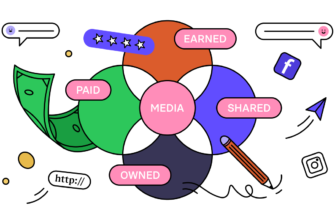- Why look for alternatives to Shopify?
- What to consider when choosing a Shopify analogue?
- Best Shopify Competitors for Launching an Online Store
- BigCommerce
- Pros
- Cons
- Who is it suitable for?
- Tariff plans
- WooCommerce
- Pros
- Cons
- Who is it suitable for?
- How much does it cost to use?
- Magento
- Pros
- Cons
- Who is it suitable for?
- Cost of use
- OpenCart
- Advantages
- Disadvantages
- Who is it suitable for?
- Prices for use
- Prestashop
- Advantages
- Disadvantages
- Who suits?
- The cost of use
- Squarespace
- Pros
- Cons
- Who suits?
- Tariff plans
- Wix
- Advantages
- Disadvantages
- Who suits?
- Tariffs for use
- Square Online Store
- Advantages
- Disadvantages
- Who suits?
- Tariffs for use
- Volusion
- Advantages
- Disadvantages
- Who suits?
- Tariff plans
- Pinnaclecart
- Strengths
- Weaknesses
- Who suits?
- Tariffs for use
- Weebly
- Pros
- Cons
- Who suits?
- Tariffs for use
- Shift4shop
- Strengths
- Weaknesses
- Who suits?
- Tariffs for use
Shopify is today considered the undisputed leader in the e-commerce market. As of 2023, more than 1 million companies use the platform to organize their own online stores.
However, recently, more and more alternatives have begun to appear that can become serious competitors to Shopify. And already this year, analysts predict a redistribution of market share in this industry due to the rapid growth of other online commerce systems.
In this article, we will look at the best alternatives to Shopify for creating an online store, compare their pricing policy and set of tools, flexibility of integrations, and user-friendliness of the user interface.
How many calls and sales will I get by ordering contextual advertising from you?
I need to calculate the conversion of my website Describe
the task
in the application
Calculate potential ad revenue Google
contextual advertising calculator
Why look for alternatives to Shopify?
Each service has its own disadvantages, which force businesses to think about finding other solutions for creating an online store. Below, we will look at some of the main reasons why you should consider Shopify alternatives:
- High transaction fees. On the basic plan, Shopify charges 2.9% + 30 cents for every payment made to your store. For example, if your markup on a product is only 15%, then ~3% goes straight to commission. For some companies, especially those with low margins, this is too much.
- Difficult to scale. Although this platform is suitable for a small startup, as your business grows you may encounter some of its limitations, while alternatives may offer you more options.
- Dependency on one platform. By hosting your entire business only on Shopify, you become completely dependent on that company’s solutions. Any technical glitches, changes in search algorithms or increased commissions will directly affect your sales.
- Lack of necessary functionality. Shopify is not a one-size-fits-all solution for every niche. For example, Gumroad is better for sellers of digital goods or subscriptions, and Webflow is better for complex technical projects.
- Loading speed is not very high. By default, online stores on Shopify do not load very quickly, which is important for conversion and SEO. Alternatives, in turn, boast higher performance.
- Localization is not possible for all countries. Although the service supports a wide variety of currencies and languages, it is better to consider other platforms to bring your company to Chinese, Indian or some other markets.
- You cannot change the source code. If you need to make major changes to the design, catalog structure, or workflow of the store, it will be easier to create the store from scratch on a different CMS than to try to implement it within Shopify.
What to consider when choosing a Shopify analogue?
Before deciding on the best Shopify alternative for your business, it is important to analyze several key factors:
- Cost of use. Analyze not only the tariff plans, but also the functionality provided in each of them. An equally important criterion is the system commission for each purchase made in your store.
- Easy to use. Rate how clear the user interface of the admin panel is. Will you be able to create the project yourself, or will you have to hire a specialist? Also pay attention to the quality of training materials and instructions for new users.
- Functional. When analyzing, take into account the specifics and nuances of your niche to make sure that the functionality is enough not only to launch, but also to further scale the project.
- Technical support. Evaluate the efficiency of work and the level of qualifications of specialists based on customer reviews. Also ask if premium support is available for more complex or urgent issues.
- Safety and reliability. The platform must comply with modern security standards and ensure reliable information storage. Also analyze the data encryption protocols used, as well as protection against hacking and DDoS attacks.
- Reviews from real users. Look for opinions from real customers on independent blogs, YouTube videos from store owners, social media posts and forums. This will help you get an objective idea of all the nuances of working with the chosen solution.
Best Shopify Competitors for Launching an Online Store
There are many worthy solutions in the e-commerce market. Below, we will look at the best Shopify alternatives for starting an online store that will help you open a profitable online business.
BigCommerce

This is one of the most popular and functional platforms for creating online stores. This service was founded in 2009 and is currently actively used by more than 60 thousand online retailers around the world.
Pros
- Rich set of tools. BigCommerce provides very powerful functionality for creating and promoting an online store out of the box, so you don’t need developer services or installing third-party applications.
- Convenient and intuitive control panel. The administrative panel interface is highly ergonomic and intuitive in design. Even a novice user can easily understand the configuration. You will also be able to quickly update your product catalog, manage orders and analyze statistics.
- High loading speed. Pages are generated in a fraction of a second, and a CDN is used to deliver content, which has a positive effect on user behavior, SEO and conversion.
- Wide design possibilities. Using BigCommerce, you can create a unique store design from scratch or use ready-made templates. There is also a built-in visual designer for working with design.
- Built-in marketing analytics. BigCommerce has powerful functionality for analyzing all the key metrics of an online store, allowing you to optimize advertising campaigns and work to increase sales.
- Large number of integrations. The platform works with more than 500 services: CRM, delivery services, payment systems, data warehouses, etc.
Cons
- Fewer applications. If the Shopify App Store has as many as 6,000 extensions available for download, BigCommerce has only about 400 of them, which is much less.
- Fewer opportunities for international trade. Websites on BigCommerce are adapted to work only in 7 countries, while Shopify is suitable for opening a store in any country in the world.
- Performance problems under heavy loads. According to customer reviews, after traffic of 50,000 visitors per day, performance problems begin and pages load slowly.
- More complex scaling. If your business is growing rapidly, switching from one tariff plan to another may take a long time due to the need to migrate to other servers.
Who is it suitable for?
Despite the disadvantages listed above, this engine is an excellent choice for large online stores with a turnover of $1-5 million per year. It is also perfect for wholesalers and B2B sellers.
BigCommerce also copes well with multichannel sales – you can connect Amazon, eBay and popular social networks directly in the admin panel.
Tariff plans

BigCommerce is more expensive, especially for stores with a large volume of sales. The minimum package starts at $29.95 per month. Additionally, it is worth considering the costs of connecting paid applications and add-ons.
WooCommerce
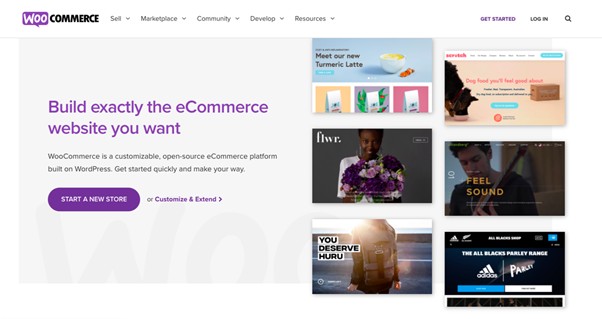
WooCommerce is one of the most popular platforms for creating online stores. This is a free plugin that is installed on the WordPress CMS.
The extension is used by more than 5 million stores worldwide. Among the well-known brands that have created their online stores on this platform are Tesla, Microsoft, Silverstone and many others.
Pros
- Huge selection of design themes. There are currently more than 7,000 free and premium WooCommerce themes available in the WordPress catalog. This allows you to quickly find a suitable template for a store in any subject.
- More tailored for SEO optimization. You can install a special Yoast or RankMath plugin, which makes it possible to fully optimize each page for the necessary queries and improve rankings in search results. Such powerful solutions do not exist for similar CMS.
- Easier to adapt to different types of business. Due to the huge number of add-ons, you can implement almost any business logic on WordPress: subscriptions, selling digital goods, trading in the B2B segment and much more.
- Possibility of quick migration from other platforms. There are ready-made solutions for transferring a store from Shopify, Magento, OpenCart, osCommerce, etc. In just a couple of clicks you can transfer the entire product catalog, orders, reviews, blog and other content. This significantly saves time and eliminates routine.
- Large and active community. There are over 1.8 million active users worldwide. They focus on thematic forums and actively post information on social networks and Telegram channels. All this helps to solve any problem, from installation and configuration to complex tasks, in the shortest possible time.
Cons
- Basic technical skills required. If working with the admin panel in Shopify does not cause any problems, then with WooCommerce you will have to tinker for some time to figure out connecting payment gateways, delivery services, etc. If you have not encountered such problems before, it is better to contact a specialist.
- Paid hosting and domain. If you only need to pay a monthly subscription fee for SaaS services, then to install WordPress you will have to pay extra for renting hosting and registering a domain name.
- Security problems. They apply to all open source CMSs – hackers are constantly looking for vulnerabilities in them and periodically find them. To protect your project, regularly monitor the latest versions of plugins and themes, and install updates in a timely manner.
Who is it suitable for?
WooCommerce will be an excellent choice for small online businesses, where the low cost of maintaining a store is important, for companies that are not suitable for a standard solution, and they plan to customize the project as much as possible.
However, this system is not suitable in cases where you need to quickly launch a website without going into technical details.
How much does it cost to use?
This is a free plugin for WordPress that does not require any subscription fee. You will only need to pay annually for the domain and hosting, and that’s it. At the same time, there is also a premium version of the extension, which opens up additional features.
Magento

This is a powerful open-source engine, aimed primarily at medium and large businesses. It provides a huge range of tools to automate business processes right out of the box.
This is another Shopify alternative, aimed primarily at developers – it is difficult to learn and is not suitable for small startups due to its very high price.
Pros
- More opportunities for large projects. Magento was originally created as a tool for scaling a business. The platform can handle hundreds of thousands of products and thousands of orders per day.
- Better suited for B2B. There are different pricing rules for different categories of clients, you can divide buyers into groups, issue an invoice for non-cash payments, and much more.
- Open source. This allows experienced developers to change and modify any part of the platform code to suit the needs of a specific business.
- Internal reporting. Magento comes with built-in powerful analytics covering all aspects of e-commerce – from conversion to logistics.
- Multi-channel sales. You can set up several sales channels at once from one control panel. Here you can connect popular marketplaces (eBay or Amazon), a mobile application or a POS terminal for offline trading.
Cons
- It is difficult to change the theme of the design. If in Shopify this is done in a couple of clicks, then for Magento this is a complex task, often requiring help from an experienced developer.
- Slower operating speed. Due to the complexity of the architecture, performance issues may arise as the load increases. To solve them, you will need to move to a dedicated server with powerful hardware.
- We need help from technical specialists. This is one of the most difficult platforms to master, therefore it will not be possible to create a website on this engine and maintain its functionality on your own.
Who is it suitable for?
This solution is designed for experienced users who have a serious start-up budget and are ready to invest in development for subsequent business automation. It is extremely irrational to use an engine for a small store with a couple of hundred product items.
It is suitable for non-trivial, complex international projects that require fine-tuning of business logic, multilingual capabilities, and basic logistics processes.
Cost of use
Magento has a very complex architecture, and therefore even a basic installation will require a significant investment in programmer and web designer hours. At the same time, the CMS itself has both a free version with reduced capabilities and a paid one – from $2000 monthly.
OpenCart
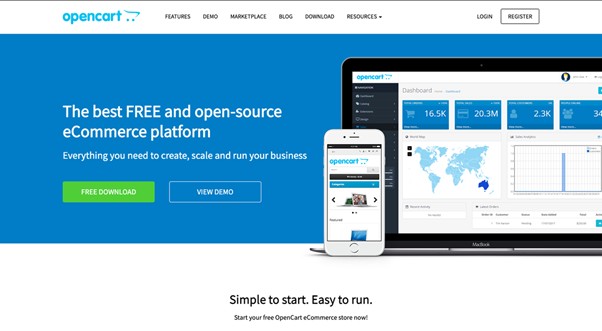
This is a free open-source e-commerce platform based on PHP and MySQL. It was released in 2014 and has been quite popular ever since. OpenCart is built on a modular architecture, which makes it easy to add new functionality by installing extensions.
Advantages
- Multilingual. The engine is localized into dozens of languages, including Russian and Ukrainian. This greatly simplifies access to international markets and makes it a convenient solution for trading in several countries at the same time.
- Possibilities for expansion. You can scale to a large marketplace with hundreds of thousands of products and visitors per day. And you don’t need to change your tariff plan for this, like in Shopify.
- Better performance. OpenCart can easily handle hundreds of thousands of visitors per day, and millions of products can be added to the catalog. As the load increases, you can simply buy more powerful hosting.
- All data is on your server. When planning a business for years to come, this is a very important advantage over Shopify, where the database with information about customers, orders and products is tied to the platform and can be lost when changing providers.
Disadvantages
- The entry threshold is higher. For those new to eCommerce, the CMS may seem difficult to learn compared to Shopify, where everything already works out of the box.
- High requirements for technical support. The administrator will need to independently monitor updates, fix vulnerabilities, and resolve emerging technical issues. For this, the help of enthusiasts from forums may not be enough.
- Fewer selection of ready-made templates. A truly customized solution will most likely have to be ordered from an external layout designer.
Who is it suitable for?
Choose OpenCart only in cases where you are ready to independently delve into and understand the logic of the engine, install modules and configure integrations. This is not a simple solution that is ready to work right out of the box.
Prices for use
Open source code allows you to enjoy all the benefits of the system for free. However, it is necessary to budget for improvements, purchase of modules and server rental.
Prestashop
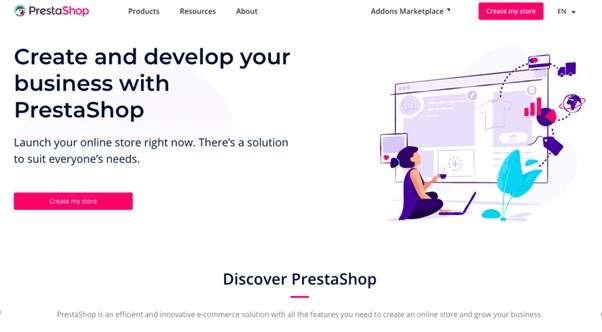
This is a well-known open-source engine written in PHP and working with MySQL databases. The first version was released in 2007 in France, and since then the solution has been localized for dozens of countries. The system has a modular architecture that allows you to expand functionality as needed.
Advantages
- Optimization for search engines. Due to the open source code, you can add any code to the HTML structure – connect micro markup, display meta tags, SEO texts in the right place. These features are not provided for closed systems.
- Multilingual. PrestaShop has been translated into dozens of languages, including Russian. Also, for different countries, you can connect their native currency for accepting payments and local delivery services.
- Better performance. The open architecture allows you to optimize speed as your workload grows. Due to this, stores can withstand millions of visitors per day and hundreds of thousands of orders per month without damage.
Disadvantages
- You need to deal with the configuration yourself. Prestashop does not have official free support. We will have to rely on our own strength in many technical matters – to study forums, establish updates and additions, try to optimize performance.
- more effort is required. To start the project, you will need to buy hosting, pour files to the server, connect the database. This will not only take a lot of time, but can also be too difficult for a beginner.
- Not all possibilities are available in the free version. In addition to the basic version of Prestashop, it also offers customers Plus and Performance packages, which will need to be paid for the use of.
Who suits?
Despite the fact that this competitor Shopify is initially focused on the Western market, Prestashop is actively gaining popularity among Ukrainian online retailers. It is most optimal for small and medium-sized businesses – from startups to companies with a turnover of tens of millions of hryvnias per year.
The cost of use
The main version is completely free for downloading and using – no licensing deductions, etc. However, during operation it makes sense to consider the commercial versions of the engine, the prices of which start from $250 monthly.
Squarespace

How many calls and sales will I get by ordering contextual advertising from you?
I need to calculate the conversion of my website Describe
the task
in the application
Calculate potential ad revenue Google
contextual advertising calculator
This is an American service for creating and managing websites based on templates. The company was founded in 2003 and currently serves more than 2 million Internet projects around the world. In addition to simple landings and visits sites, SquareSpace allows you to create full-fledged stores from zero with the connection of payment gateways, delivery services and other things.
Pros
- Intuitively understandable interface. You do not need to have programming or miles to make changes on the pages, edit the structure, create a menu, etc.
- Integration with marketing tools. The service can be easily associated with Google Analytics, emails and targeted advertising rooms. This will significantly save the administrator time.
- Functional for blogs. You can create a column of the author, edit comments, subscriptions for materials directly in the administrative panel. This allows you to use the service for content projects.
- Transparent pricing policy. No “surprises” – in SquareSpace all tariffs are spelled out as clearly as possible with specific traffic limits, the volume of the storage and the number of goods.
Cons
- lack of a full-fledged trial period. The trial version of SquareSpace, which is provided for 7 days, does not allow to fully evaluate the service, since the functionality in it is significantly cut.
- Closed ecosystem. All content and customer data are tied to the service, therefore, when moving, they will have to be transferred in manual mode.
- Suitable for large projects. Although the system can withstand the loads of up to 1 million visitors per month, it is more suitable for startups and small businesses in architecture and optimization.
Who suits?
SquareSpace is suitable for the quick creation of spectacular landing, promo sites for short-term promotions and small stores that do not need complex logistics and deep customization.
Tariff plans
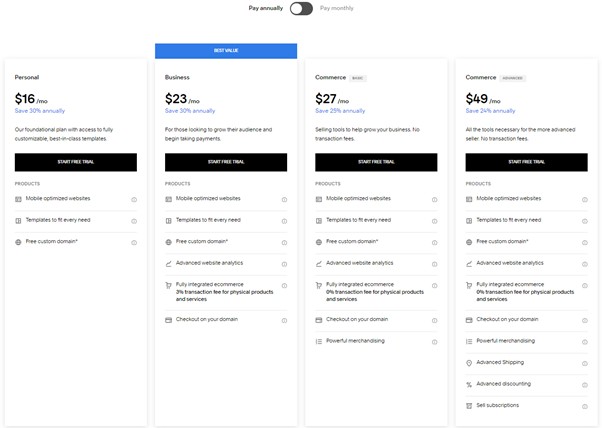
All plans are provided on a paid basis, prices start at $12/month. This imposes costs already at the stage of testing a business model and, perhaps, not very profitable for startups.
Wix

This is a popular Israeli online designer, which can also be called an analogue of Shopify, since it can be created not only by Landing Page, but also by Ecommerce projects. The service was founded in 2006 and during this time more than 200 million web resources were created on its basis.
Advantages
- easier in development for beginners. The WIX intuitive designer with a convenient visual interface and ready-made templates is built in, which significantly accelerates and facilitates the development.
- built -in complex analytics. In the Wix Analytics internal service, you can track traffic, sales, audiences and much more from one panel without connecting third -party applications.
- More patterns and applications in free tariffs. Even the initial packages include access to a gallery of hundreds of templates and useful additions.
Disadvantages
- Weak SEO-optimization. The HTML code contains a lot of “garbage” and unnecessary scripts, and optimization settings are limited, due to which it is much more difficult to achieve good positions in the issuance.
- lack of a full-fledged multi-language version. Wix allows you to create only a simplified multi-language version with a built -in interface translation into several languages.
- It is impossible to export the data. When transferring a store to another platform, it will not be possible to pick up the product catalog and customer orders, unlike other competitors Shopify.
Who suits?
Wix is optimal for beginners without experience in Ecommerce, sellers for whom beautiful visual design is important, as well as those who are important to quickly start the project without deep immersion in technical details. However, it is not recommended for medium and large stores, since this is not a specialized solution.
Tariffs for use
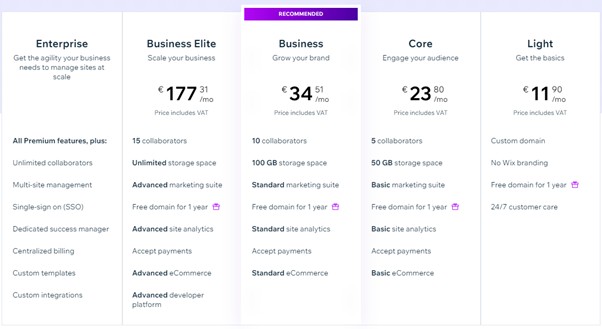
Prices start from 11 euros per month. There is also a free version of the product with full access to most important functions, but with the Wix advertising banner and without binding its domain.
Square Online Store
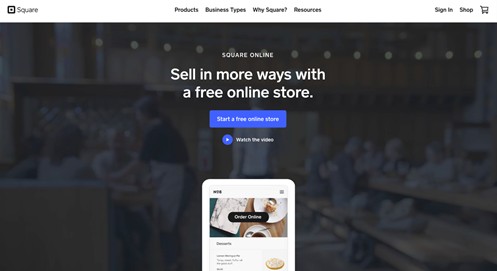
This is a solution for creating online stores from the popular Square service to accept payments, which allows you to quickly and budget launch a full-fledged project in the field of e-commerce.
Advantages
- built -in integration with Square. Allows you to use one account for the site and offline payments in physical points. Due to this, multi -sales scheme is implemented.
- A full-fledged free mobile application. Allows you to administer the web resource directly from the smartphone on iOS or Android – add new products, process applications, etc.
- Low commissions. For each transaction in Square Online Store, you will pay only from 2.6% + 30 cents. At the same time, Shopify the standard commission is higher.
Disadvantages
- is not so good for scaling. When pouring several thousand commodity positions, problems can begin, expressed in slow speed of work and too much load on the server.
- There is no partner program. Square Online Store is in no hurry to create a partnership for bloggers, which would provide for any percentage of sales on the recommendation. Therefore, it is not as common as many analogues.
- There is not enough training in working with the system. For novice sellers, no training materials or video tutorials are provided, following the example of Shopify Academy.
Who suits?
is suitable for novice startups that appreciate the simplicity of setup, businesses interested in saving on commissions, as well as those who need the integration of online and offline payments.
Tariffs for use
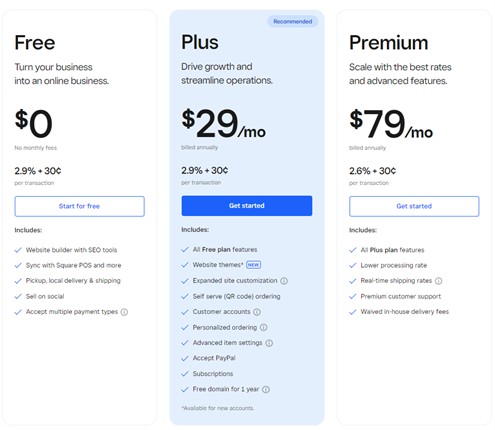
Tariffs start from $29/month. At the same time, it is possible to use free use, however, with some restrictions and the availability of commissions for each transaction. The most expensive plan “Premium” will cost $79/month.
Volusion

This is a cloud SaaS platform that provides a convenient designer for independent layout of the pages, as well as the ability to send letters, SMS and coupons on the database of customers directly from the control panel.
Advantages
- built -in loyalty system. With the help of it, for each order to the buyer, points are awarded, which can then be exchanged for gifts or discount, which helps to increase the conversion.
- Support for price rules. You can segment a client base by providing certain groups with a discount or sending personalized mailings.
- Support for multi languages. The Volusion “out of the box” supports Spanish, French and German for the control panel and the front of the End, without the need to install additions or transfer manually.
Disadvantages
- Work on a third -party hosting. If Shopify works on its own CDN company, on its servers, then Volusion relies on third -party services. Therefore, with large loads, the load speed may fall.
- seo and marketing. If in the Shopify there is a ready-made integrated solution for generating meta tags, then his competitor needs to be tuned manually. It is also quite difficult to configure through an analytics in Volusion, and in the analogue this is done in 1–2 clicks.
- Safety. The system is more susceptible to hacking and theft of data. Previously, problems have already been recorded with leaks of customer data on sites with this CMS.
Who suits?
Voyushnes – an excellent choice for entrepreneurs who need complete control over the structure of the grocery directory, those who plan to expand the assortment in the medium term, as well as those who can periodically allocate the budget for improvement as the project grows.
Tariff plans
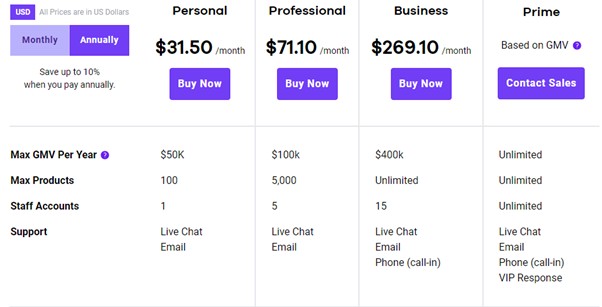
Compared to the competitor, Volusion costs a little cheaper. The difference is especially noticeable on average tariff offers. At the same time, each tariff is limited by the turnover when calculating per year – by exceeding a certain mark (for example, $50,000 for Volusion Personal) will automatically transfer you to a higher tariff.
Pinnaclecart
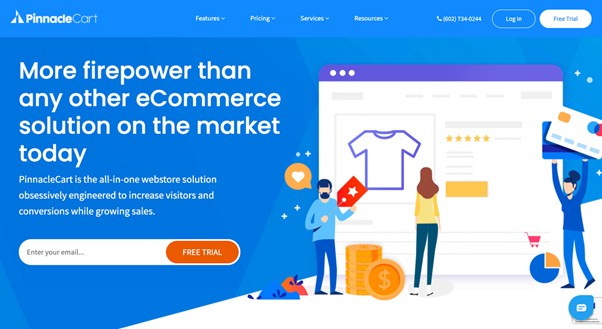
This SaAS platform for Ecommerce has existed since 2008 and may be a good solution for small and medium Internet projects. Pinnaclecart allows you to launch a full-fledged store with the support of multi -lunity, multi -sized, various methods of receiving transactions and delivery.
Strengths
- more freedom in the configuration. Unlike the rather strict Shopify restrictions, here you can deeper customic and processes through built -in tools or API.
- Free SSL certificate. This bonus is included on all tariff plans for Pinnaclecart. It allows you to give a site through a protocol protected HTTPS, which plays an important role in obtaining organic traffic from a search.
- Dropping. The service is sharpened to work directly with suppliers and sending goods on their behalf. This saves the budget for the maintenance of its warehouse, logistics services, etc.
Weaknesses
- less finished templates. Although the design can be configured “for yourself”, the number of beautiful topics available for use is much less than that of analogues. We will have to spend money on designing design or development from scratch.
- less intuitive interface. Although the PINNACLECART admin panel is quite detailed, nevertheless, in terms of usability and ease of development, many competitors look better for beginners.
- Low fame and distribution. Pinnaclecart loses in the recognition of the brand and the number of ready-made integrations from third -party developers, in comparison with market leaders.
Who suits?
This CMS will especially appeal to those who need integration with complex logistics and accounting systems, plans to use the drop-shipping model with direct deliveries from manufacturers, as well as those who can allocate a certain supply of visual finalization.
Tariffs for use
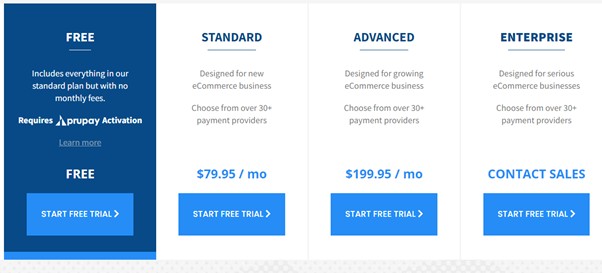
At the initial stage of PINNACLECART, you can use it for free, but for paid options, the tariffs “bite” – even for the most inexpensive you will have to give $ 79.95/month. At the same time, a free trial period is provided for testing.
Weebly

This is a fairly common designer of sites, which also offers solutions to create online stores. Even a beginner without programming skills can construct landing pages by dragging blocks and widgets with a mouse.
Pros
- easier in development. Weebly is very simple and intuitive. Even a novice webmaster without experience can easily create a Landing Page or even a store, without spending a lot of time to understand the process.
- Support for multilingual. The service works in English, Spanish, French, Italian, Portuguese, German and other languages. The translation is loaded automatically, for this you do not need to install special applications or engage in handmade translation.
- The ability to connect your domain. If desired, the Weebly account can be transferred to your own domain so that the site does not depend on the platform.
Cons
- technical support. Despite the extensive base of knowledge, the quality and speed of the Weebly support, judging by the reviews, can sometimes cause complaints from customers.
- more stringent conditions for withdrawal of funds. For the amount of the amount, when withdrawing to a bank account, some restrictions are imposed. In particular, there is a minimum threshold by the amount of the withdrawal.
- Less choice of applications. Ready-made additions to Weebly App Store are only about 200. At the same time, many analogues provide a choice of 1000 or more.
Who suits?
Weebly will appeal to the owners of small trading platforms with a highly specialized assortment, startups who need to quickly and inexpensively test the idea, as well as online video without the possibility of placing an order.
Tariffs for use
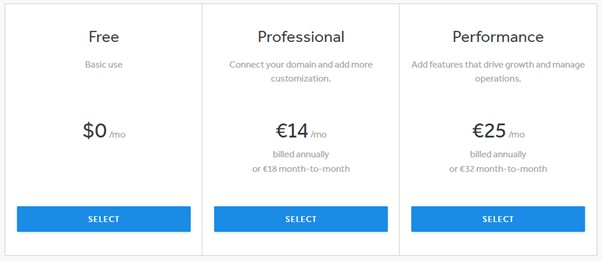
The service is not expensive, a free plan with basic functions is also provided. In addition, a discount is provided for payment immediately in a year. At the same time, the minimum price of the premium package starts from 14 euros.
Shift4shop

Another designer of e-commerce, which can be considered as an alternative to Shopifai. Thanks to flexible settings, the service is suitable for many types of Internet business and provides for integration with popular analytics, marketing and accounting systems.
Strengths
- Support for offline sales. Using POS-terminals, you can, through one convenient panel, the control to synchronize the purchase base through online and offline channels, which is suitable for a mixed business model.
- Drop-shipping. SHIFT4SHOP is optimized for building a business on drop-shipping – direct integration with suppliers and shipping on their behalf. Thus, you do not need to contain your warehouse and pay salaries to couriers.
- Work on your domain name. You can tie your domain to Shift4Shop instead of a subdomain, which is by default the system. This increases the image and recognition of the brand.
Weaknesses
- Support. Despite the presence of a knowledge base and documentation, the quality and efficiency of technical support sometimes causes user complaints compared to competitors.
- lack of some important functions. For example, there is no restoration of abandoned baskets – one of the key metrics of the conversion optimization in EC
- The smaller fame of the brand. Shift4Shop is still losing in recognition and trust from users, and also does not have such a powerful community on the Internet as more promoted analogues.
Who suits?
Shift4shop is suitable for testing a business idea before switching to a more specialized CMS. It is also good for companies planning to accept offline quenches and small catalogs of goods and services.
Tariffs for use

It is possible to use free use with a minimum turnover of $500. Then, Shift4Shop earns with a commission that comes from transactions. But premium plans begin from $299.













